6.3: Meiosis Protocol
- Page ID
- 25134
Almost all the cells in your body were produced by mitosis. The only exceptions are the gametes– sperm or eggs – which are produced by a different type of cell division called meiosis.
During fertilization, the sperm and egg unite to form a single cell called the zygote which contains all the chromosomes from both the sperm and the egg. The zygote divides into two cells by mitosis. Then, these cells each divide by mitosis. This process repeats many times to produce the cells in an embryo which develops into a baby.
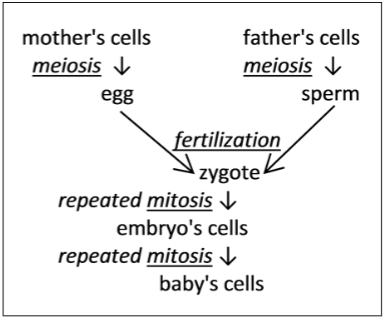
1. Each cell in a normal human embryo has 23 pairs of homologous chromosomes, for a total of 46 chromosomes per cell. How many chromosomes are in a normal human zygote? Explain your reasoning.
2. What would happen if human sperm and eggs were produced by mitosis? Explain why this would result in an embryo which had double the normal number of chromosomes in each cell. A human embryo with that many chromosomes in each cell would be abnormal and would die before it could develop into a baby. So, gametes can not be made by mitosis.
3. Each human sperm and egg should have ____ chromosomes, so fertilization will produce a zygote with ____ chromosomes; this zygote will develop into a healthy embryo with ____ chromosomes in each cell.
4. Each sperm and each egg produced by meiosis has only one chromosome from each pair of homologous chromosomes. When a sperm and egg unite during fertilization, the resulting zygote has ____ pairs of homologous chromosomes. For each pair of homologous chromosomes in a zygote, one chromosome came from the egg and the other chromosome came from the _______________. A cell that has pairs of homologous chromosomes is diploid. A cell that has only one chromosome from each pair of homologous chromosomes is haploid.
5. Next to each type of cell in the above chart, write:
- The number of chromosomes in that type of cell
- A d for diploid cells or an h for haploid cells.
Meiosis – Cell Divisions to Produce Haploid Gametes
Before meiosis, the cell makes a copy of the DNA in each chromosome. Then, during meiosis there are two cell divisions, Meiosis I and Meiosis II. These two cell divisions produce four haploid daughter cells.
Meiosis I is different from mitosis because each pair of homologous chromosome lines up next to each other and then the two homologous chromosomes separate. (The figure shows Meiosis I for a cell with a single pair of homologous chromosomes; the stripes on the chromatids of one of the chromosomes indicates that this chromosome has different alleles than the other homologous chromosome.)
Meiosis I produces daughter cells with half as many chromosomes as the parent cell, so the daughter cells are haploid. Each daughter cell has a different chromosome from the original pair of homologous chromosomes.
6. In the figure for Meiosis I, label the diploid cell, the pair of homologous chromosomes in this diploid cell, and the two sister chromatids in one of these chromosomes.
7. Do the chromosomes in the two daughter cells produced by Meiosis I have the same alleles for each gene? Explain your reasoning.
Meiosis II is like mitosis since the sister chromatids of each chromosome are separated. As a result, each daughter cell gets one copy of one chromosome from the pair of homologous chromosomes that was in the original cell. These haploid daughter cells are the gametes.
8. Use asterisks to indicate the cells in this figure that represent sperm produced by meiosis.
Modeling Meiosis to Understand How Meiosis Produces Genetically Diverse Gametes
To model meiosis, you will use the same pairs of model homologous chromosomes that you used to model mitosis. A person with these chromosomes would have the genotype AaSsLl.
9. What phenotypic characteristics would a person with this genotype have? Circle the appropriate phenotypic characteristics in this table.
| Genotype | ⇒ | Protein | ⇒ | Phenotype (characteristics) |
|
AA or Aa |
⇒ |
Enough normal enzyme to make melanin in skin and hair |
⇒ |
Normal skin and hair color |
| aa | ⇒ |
Defective enzyme for melanin production |
⇒ |
Albino (very pale skin and hair color) |
| SS or Ss | ⇒ |
Enough normal hemoglobin to prevent red blood cells from becoming sickle-shaped. |
⇒ |
Normal blood (no sickle cell anemia) |
| ss | ⇒ |
Sickle cell hemoglobin |
⇒ | Sickle cell anemia |
| LL or Ll | ⇒ |
Defective enzyme (defective protein inactivates any normal enzyme) |
⇒ |
Alcohol sensitive (skin flush and discomfort after drinking alcohol) |
| ll | ⇒ | Normal enzyme for alcohol metabolism | ⇒ | Not alcohol sensitive |
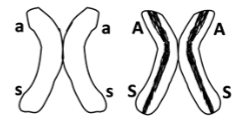
You will begin modeling meiosis with only one pair of the model chromosomes.
- Use this pair of model chromosomes to model each step of meiosis. Use string to model the cell membranes at each stage.
10. Show the results of your modeling in this figure. Sketch and label the chromosomes in each cell that is produced by Meiosis I and by Meiosis II.

11. You have modeled meiosis, beginning with a diploid cell that has the alleles AaSs. The haploid gametes produced by meiosis have the alleles:
- ______ AS or as
- ______ AASS or aass
- ______ AaSs
Next, you will model meiosis using both pairs of model chromosomes. At the beginning of Meiosis I each pair of homologous chromosomes lines up independently of how the other pairs of homologous chromosomes have lined up. This is called independent assortment. As a result of independent assortment, at the beginning of Meiosis I the as chromosome can be lined up on the same side as either the l chromosome or the L chromosome (see figure).
- Use your four model chromosomes to model Meiosis I and Meiosis II for both of the possible ways of lining up the model chromosomes at the beginning of Meiosis I.
12. Record the results of your modeling in this chart.
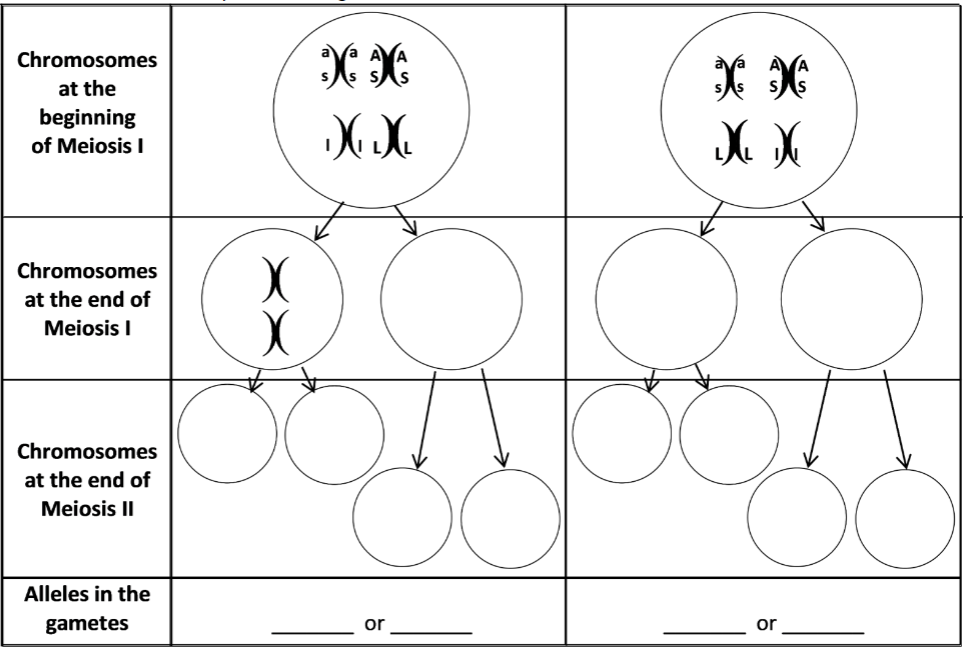

When a pair of homologous chromosomes is lined up next to each other during Meiosis I, the two homologous chromosomes can exchange parts of a chromatid. This is called crossing over.
13a. On each chromatid of the chromosomes in the bottom row of this figure, label the alleles for the genes for albinism and sickle cell anemia. When these chromosomes and chromatids separate during Meiosis I and II, this produces gametes with four different combinations of alleles for the genes for albinism and sickle cell anemia.
13b. The combinations of alleles in the different gametes are:
__AS__ _____ _____ _____
14a. Explain why different gametes produced by the same person can have different combinations of alleles for genes that are located on two different chromosomes.
14b. Explain why different gametes produced by the same person can have different combinations of alleles for two genes that are located far apart on the same chromosome.
Comparing Mitosis and Meiosis
15a. In this figure, label the column that shows meiosis and the column that shows mitosis.

15b. What are some similarities between cell division by mitosis and cell division by meiosis?
15c. Complete this table to describe some important differences between mitosis and meiosis.
| Characteristic | Mitosis | Meiosis |
| # of Daughter Cells | ||
| Type of Cells Produced | ||
| Genetic Differences or Similarities between Daughter Cells | ||
| # of Cell Divisions |
16. Complete these diagrams to show how a pair of homologous chromosomes is lined up in a cell at the beginning of mitosis vs. the beginning of meiosis I.

17. Match each item in the top list with the appropriate match from the bottom list.
Mitosis separates _____
Meiosis I separates _____
Meiosis II separates _____
a. pairs of homologous chromosomes
b. sister chromatids
18. Explain why sexually reproducing organisms need to have two different types of cell division. What are the advantages of mitosis and of meiosis?
Analyzing Meiosis and Fertilization to Understand Inheritance
In this section, you will learn how events during meiosis and fertilization determine the genetic makeup of the zygote which in turn determines the genotype of the baby that develops from the zygote. You already know that sisters or brothers can have different characteristics, even though they have the same parents. One major reason for these different characteristics is that the processes of meiosis and fertilization result in a different combination of alleles in each child.
You will model meiosis and fertilization for a very simplified case where there is only one pair of homologous chromosomes per cell and only one identified gene on each chromosome.
To produce the two pairs of model chromosomes shown in this figure, you will need a pair of the as and AS model chromosomes in one color and a pair of the l and L model chromosomes in a different color. Tape blank strips of paper on these model chromosomes to cover the S, s, L, and l alleles. Then, tape strips with the a and A alleles to create a second pair of model chromosomes which have the a and A alleles.
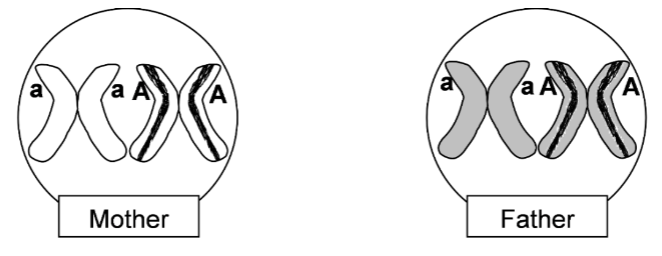
Modeling Meiosis and Fertilization to Understand Inheritance
One person in your group should use one pair of model homologous chromosomes to demonstrate how meiosis produces sperm. Another person should use the other color pair of model homologous chromosomes to demonstrate how meiosis produces eggs.
19. For each type of sperm and egg produced by meiosis, write the allele in an appropriate white box in this chart.
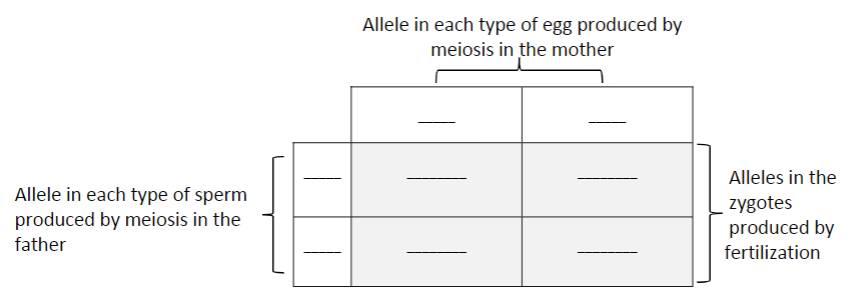
- Use chalk to outline the rectangles of this chart on your lab table. Put a model chromosome for each type of sperm and egg in each of the boxes on the top and on the left.
- Use one of the sperm to fertilize one of the eggs to produce a zygote. The resulting zygote will have one chromosome from the egg and one from the sperm. Note the genetic makeup of this zygote in the appropriate gray box in the chart above.
- Model fertilization three more times, pairing each type of sperm with each type of egg.
20. Write the genetic makeup of each type of zygote in the appropriate box in the shaded area in the chart.
21. Each person began as a zygote. Explain why each person has the same genetic makeup as the zygote he or she developed from.
22. In the above chart, write in the phenotypic characteristic (albinism or normal skin and hair color) for the mother, the father, and the person who would develop from each zygote. Circle the zygotes that would develop into a person with the same phenotypic characteristic as the parents. Use an asterisk (*) to mark the zygote that would develop into a person who would have a different phenotypic characteristic that neither parent has.
23a. Explain why many children have the same phenotypic characteristics as their parents.
23b. Explain how a child can have a different phenotypic characteristic that neither parent has.
Why are Siblings Different from Each Other?
Your analysis of the inheritance of a single gene showed how meiosis and fertilization can result in genetic and phenotypic differences between siblings produced by the same mother and father. Now you will analyze the results of meiosis and fertilization for multiple genes. You will see how meiosis and fertilization result in the many genetic and phenotypic differences between siblings.
Remember that AaSsLl parents can produce multiple different types of gametes with different combinations of the alleles for the albinism gene, sickle cell gene, and alcohol sensitivity gene (see page 4). As a result of independent assortment and crossing over, an AaSsLl parent can produce eight types of gametes: asl, ASL, asL, ASl, aSl, aSL, AsL, and Asl.
Obviously, fertilization of the eight different types of eggs by the eight different types of sperm could result in offspring with many different genotypes. In question 24, you will describe the outcomes for fertilization of a few of the possible types of eggs by one of the possible types of sperm.
24. Complete the following chart to describe the genetic makeup and phenotype of some of the possible outcomes of fertilization between the different types of eggs and sperm produced by AaSsLl parents.
| Alleles in Egg | Alleles in Sperm | Alleles in Zygote | Phenotype of Person who will Develop from this Zygote (Hint: See the Table in Question 9) | ||||
| ASL | asl | AaSsLl | |||||
| ASl | asl | ||||||
| aSl | asl | ||||||
This illustrates how, even when we consider only three genes with two alleles each, meiosis and fertilization can produce zygotes with many different combinations of alleles which can develop into people with many different combinations of phenotypic characteristics. The actual amount of genetic diversity possible in the children produced by one couple is much greater since each person has thousands of genes on 23 pairs of homologous chromosomes.
25. Explain why no two siblings have exactly the same combination of alleles inherited from their parents (except for identical twins who both developed from the same zygote). Begin with the observation that each person has thousands of genes on 23 pairs of homologous chromosomes. Include in your explanation the terms genes, alleles, chromosomes, meiosis, independent assortment, crossing over, eggs, sperm, fertilization, and zygote.
A Mistake in Meiosis Can Cause Down Syndrome
You have seen that normal meiosis and fertilization can produce a lot of genetic variability in the different children produced by the same parents. Additional genetic variability can result from mistakes in DNA replication (which can cause mutations) or mistakes in meiosis. For example, when meiosis does not happen perfectly, the chromosomes are not divided equally between the daughter cells produced by meiosis, so an egg or a sperm may receive two copies of the same chromosome.
26. Suppose that a human egg receives two copies of a chromosome, and this egg is fertilized by a normal sperm. How many copies of this chromosome would there be in the resulting zygote? ____
- How many copies of this chromosome would there be in each cell in the resulting embryo? ____
When a cell has three copies of a chromosome, the extra copies of the genes on this chromosome result in abnormal cell function and abnormal embryonic development. To understand how an extra copy of one chromosome could result in abnormalities, remember that each chromosome has genes with the instructions to make specific types of proteins, so the extra chromosome could result in too many copies of these specific proteins. Think about what would happen if you added too much milk to a box of macaroni and cheese. The mac and cheese would have too much liquid and be runny instead of creamy. Cells are much more complicated than mac and cheese, and a cell cannot function properly when there are too many copies of some types of proteins due to an extra copy of one of the chromosomes.
When the cells in an embryo do not function properly, the embryo develops abnormalities. For example, some babies are born with an extra copy of chromosome 21 in each cell. This results in Down syndrome with multiple abnormalities, including mental retardation, a broad flat face, a big tongue, short height, and often heart defects.
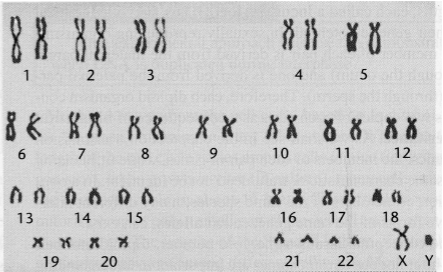
The figure above shows a karyotype for a normal boy. A karyotype is a photograph of a magnified view of the chromosomes from a human cell, with pairs of homologous chromosomes arranged next to each other and numbered. In the karyotype, each chromosome has double copies of its DNA, contained in a pair of sister chromatids linked at a centromere.
27. Label the sister chromatids in chromosome 3 in the karyotype.
- Draw in an extra chromosome 21 to show the karyotype of a boy with Down syndrome.
28. In most cases, an embryo which has an extra chromosome in each cell develops such severe abnormalities that the embryo dies, resulting in a miscarriage. For example, an extra copy of any of the chromosomes in the top row of the karyotype results in such severe abnormalities that the embryo always dies. In contrast, an extra copy of chromosome 21 results in less severe abnormalities so the embryo can often survive to be born as a baby with Down syndrome. What do you think is the reason why the third copy of chromosome 1, 2, 3, 4 or 5 results in more severe abnormalities than a third copy of chromosome 21?

